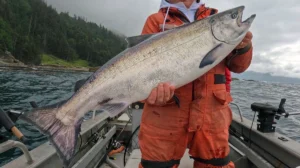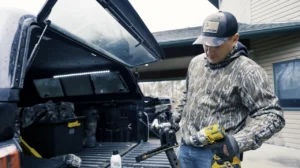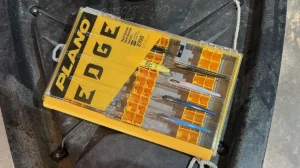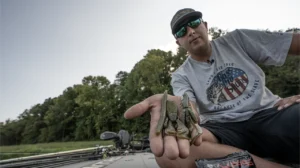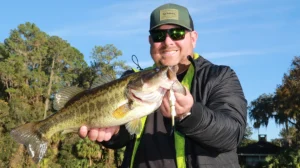There’s few things I enjoy more than float tube fishing. I got my first when I was about 12 years old, after saving all my snow shoveling money to buy one. Since then, I’ve looked for any excuse to use it. This unique method delivers a quiet, up-close fishing experience that’s hard to replicate from shore or even a boat. It’s hard to beat the tranquility afforded by a float tube, bobbing along quietly and sneaking up on fish, while drinking up the beauty of whatever body of water you’re floating in.
From remote alpine lakes to overgrown backwater sloughs, float tubes offer a lightweight, low-cost way to reach fish others can’t. If you’re looking for a new way to target pressured bass or cruise silently into a cove brimming with trout, read on — float tube fishing might just change the way you look at small water.
What Is Float Tube Fishing?
Float tubes are personal, inflatable crafts designed to keep you partially submerged while seated comfortably just above the water. The definition of “float Tube” has expanded a bit in recent years, with a few different types of inflatable vessels aimed at fishing gaining in popularity. Using fins on your feet for propulsion, or short oars in some cases, anglers maneuver silently and precisely. Though traditionally thought of as a craft to fly fish from, they offer anglers using conventional gear an exciting way to fish, too.
Why Choose a Float Tube?

Float tubes allow a nearly silent approach. There’s no hull slap, no wake, and no need to drop an anchor loudly. You’re as subtle as a drifting log, which makes all the difference when casting to skittish fish in shallow water. They take advantage of a concept called Snell’s window, which is how the refractive properties of water affect how fish see the world above the surface. By sitting low in the water, anglers remain out of the line of sight. This lets them sneak up on even the wariest fish.
Inflatable vessels, including float tubes, typically weigh 7 to 15 pounds, making them easy to carry, even over rough terrain. When deflated, float tubes can be packed into a backpack and hauled into remote fisheries that see little pressure. With the right inflatable, even hike-in lakes are fair game.
The ability to leave the bank can greatly increase your chances of catching fish. Many of the best fishing spots lie just beyond a long cast — over a weed bed, beyond fallen timber, or across a narrow channel. A float tube lets you park right where the fish are holding.
Float tube fishing is more affordable than other vessels. With entry-level setups available for under $300, float tubes offer an economical gateway into waterborne angling — especially when compared to kayaks or powered boats. Brands like Classic Accessories, Caddis, and Outcast are proven choices.
Types of Inflatable Boats
While round tubes once ruled the market, there are now a variety of inflatable vessels on the market. Still broadly referred to as float tubes, there are a multitude of varieties available. Inflatable boats have carved out a strong niche in the fishing world, offering portability, versatility, and accessibility to anglers of all levels.
Whether you’re hiking into a remote lake or drifting down a slow-moving river, inflatable crafts provide a flexible solution for reaching those hard-to-access fishing spots. From compact float tubes to rugged frameless rafts, today’s inflatable options are more durable and effective than ever. Here’s a breakdown of the primary types of inflatable boats used in fishing and what makes each unique.
Float Tubes

Best For: Stillwater fishing in lakes and ponds
Transportability: Extremely portable – fits in a backpack
Skill Level: Beginner to intermediate
Float tubes are the minimalist’s answer to getting on the water. Shaped like a donut or U, these single-person crafts let anglers sit with their legs submerged, kicking with fins to maneuver quietly into position. They’re ideal for fishing on calm lakes and are beloved by backcountry anglers for their lightweight build. Most float tubes come equipped with integrated pockets, backrests, rod holders, and mounting points for electronics. Models like the Classic Accessories Cumberland and the White River Fly Shop Lost Lake are angler favorites.
Pros:
- Incredibly lightweight and compact
- Great for stealthy approaches
- Affordable
Cons:
- Limited to calm waters
- Slower movement and control
- Lower visibility in water
Inflatable Pontoon Boats

Best For: Rivers, lakes, and slow-moving streams
Transportability: Packable but bulkier than float tubes
Skill Level: Intermediate to advanced
Pontoon boats feature two inflatable tubes (pontoons) with a seat and frame mounted between them. Rowing with oars offers better speed and control, making them great for larger bodies of water and mild river currents. Though oars are faster, many of these still allow anglers to use fins, which permit hands-free movements so anglers can focus on casting. Many models include rod holders, gear racks, and even mounts for electric motors. The Classic Accessories Colorado XTS is favored by many that hit the occasional rapid, with some even fixing motors to them.
Pros:
- Better control and rowing power
- Higher seating position for casting
- Good gear capacity
Cons:
- Heavier and bulkier than float tubes
- Takes longer to set up
- More expensive
Frameless Rafts

Best For: Rivers, backcountry access, multi-day trips
Transportability: Compact for their size; excellent for remote access
Skill Level: Intermediate to expert
Frameless inflatable fishing rafts are the evolution of the pontoon design, with a more integrated structure and no metal frame. These boats are especially popular among anglers who float rivers with variable current and terrain. Frameless rafts typically come with oar mounts, high-load capacity, and ample room for gear, making them suitable for both solo and tandem fishing. I’ve spent plenty of time fishing out of an Outcast OSG Commander, and found it handled both stillwaters and mild rapids well.
Pros:
- Extremely packable for the size
- River-capable and highly durable
- Can carry heavy loads for longer trips
Cons:
- Higher cost
- Requires some rowing experience
- Set-up and inflation take time
Choosing the Right Inflatable for You
Inflatable boats have come a long way, with today’s materials offering durability and reliability that rival hard-hulled alternatives. Your ideal inflatable fishing boat depends on your fishing style, the water you target, and how you plan to transport your gear. For short hikes and lake fishing, float tubes offer unmatched portability. If you want more comfort and power for flatwater or slow rivers, a pontoon is a reliable upgrade. For those who prioritize rugged river performance with packability, frameless rafts strike the perfect balance.
Other Considerations
While fishing from a float tube or other inflatable is a rather simple affair, there are a few considerations that you don’t have in other types of fishing. Once you’ve selected the right vessel for the water you’ll be fishing, you’ll need to grab some other gear.
Air Source
You’re going to need to fill your inflatable up. There are many different ways to go about this, but the most common is a hand-powered pump. Select one that fills on both the up and down stroke to cut down on your fill time. There are a number of models designed to use 12-volt power to rapidly fill tubes, some stopping automatically at a preset PSI reading. Or, you can get an adapter to use a standard compressor.
Waders and Footwear

Because you’ll be sitting in the water, you may want to wear waders, particularly if the water is cold. I tend to wear breathable stockingfoot waders for just about everything these days, as they offer plenty of comfort and freedom of movement.
If it’s warm enough to wet wade, you’ll still need footwear. I generally wear a pair of neoprene socks with my favorite wading boots, but there are a number of booties available that don’t require anything under them. These can be a great choice, if they offer enough support to wear with flippers.
Fins

Fins are an integral part of the float tube experience. These are what provide control and mobility. Unlike the ones aimed at SCUBA divers, these fins typically get strapped to a pair of boots or other suitable footwear. Opt for force fins or larger vented styles for efficient kicking. Just make sure they are comfortable; nothing can ruin a day like ill-fitting fins.
Safety Gear
A PFD is non-negotiable. Add a whistle, and a waterproof pouch for your phone, car keys and other sensitive items. Consider another signaling device, such as a flag, to get others’ attention on the water if needed. A repair kit with some patches and a pump is also a great idea. And make sure to let a loved one or other trusted person know your float plans.
Other Items

The simplicity of float tube fishing is part of its allure, but adding a few items adds to their versatility. Rod holders are always nice. A small anchor is great for holding position, especially if the wind kicks up. If I plan on spending most of the day on the water, I’ll pack a small soft cooler filled with a few drinks and some lunch. And though it’s certainly not necessary, you can fit a portable fish finder to many inflatables.
Fishing from a Float Tube
Float tubes and other inflatables are rather unique fishing platforms As such, they have some unique techniques to get the most out of them. Here’s a breakdown of the most effective fishing techniques when you’re on a float tube or inflatable vessel.
Kick-and-Cast: The Art of Controlled Drift

One of the biggest advantages of float tube fishing is the ability to control your drift with your legs. Wearing fins, you can slowly kick in reverse or sideways to maintain casting distance from the bank, structure, or schooling fish.
Use slow, steady kicks to stay in position, especially when targeting specific structure like submerged logs, drop-offs, or weed edges. Casting slightly ahead of your drift path lets you cover fresh water with every kick. A slow drift mimics trolling and can be deadly with streamers or soft plastics.
Precision Fishing in Tight Quarters
Float tubes let you sneak into narrow channels, lily pad fields, and shoreline pockets that boats can’t reach. However, limited casting range and low seating position mean you’ll need to dial in your accuracy.
Use roll casts or sidearm casts to present lures or flies under overhangs and into tight openings. Shorter rods (6 to 7 feet) provide more control in these confined areas. Pitching jigs or skipping soft plastics under vegetation can provoke ambush strikes from bass and panfish.
Vertical Jigging in Deep Water
Because you’re essentially suspended right above your target zone, vertical jigging becomes a high-percentage technique from a float tube, especially in lakes with depth variations.
Drop-shot rigs, blade baits, and small spoons work well. Use a fish finder (one of the portable units mentioned earlier, or go really old school and drag a “sounder,” a heavy metal weight) to locate structure and drop straight down to fish holding tight to the bottom or suspended in the water column.
Fly Fishing from a Tube

Float tubes were practically made for fly fishing. You can get within close range of rising fish, approach silently, and cast in any direction with minimal water disturbance.
Master the back cast and hauling techniques to extend your reach while seated. Intermediate sinking lines are excellent for lakes, allowing you to strip leeches, buggers, and nymphs just above weed beds. For topwater action, position yourself downwind and let the breeze push you across a cove while you strip a dry fly or popper.
Play the Wind
Wind can be both friend and foe in a float tube. Drifting with the wind allows you to cover water without kicking, but too much wind can push you off target or into trouble.
Use a small, collapsible anchor or a sea anchor or drift sock to slow your drift. This gives you time to work your lure or fly through high-probability zones. You can also anchor with your feet in shallow areas by digging into the bottom to hold position.
Trolling with Fins

Believe it or not, trolling is absolutely possible from a float tube or inflatable kayak. It’s a low-impact method that’s especially effective in stillwater. The erratic motion imparted by kicking or oar strokes does wonders for your lure or fly’s action.
Kick slowly and consistently while dragging a streamer, crankbait, or spinner behind you. Use a rod holder or hold your rod loosely across your lap, keeping tension to feel subtle takes. Vary your depth and speed until you dial in the bite.
Final Thoughts

Fishing from a float tube or inflatable vessel opens up a whole new world of opportunity. These lightweight, portable crafts allow anglers to access hard-to-reach waters, navigate quietly through productive zones, and experience fishing with a level of intimacy and stealth that larger boats can’t provide.
In a world where bigger is often mistaken for better, these small crafts prove that sometimes the best way to catch more fish is to slow down and get a little closer to the water. So grab your fins, pack light, and paddle your way into water most anglers only dream of. There’s a lot of fish out there — and now you’ve got a whole new way to find them.



![[VIDEO] How to Install the Garmin Force Pro Trolling Motor](https://www.wired2fish.com/wp-content/uploads/2025/06/trolling-motor-install-300x169.webp)

![[VIDEO] Transforming a Pontoon into a Versatile Fishing Machine](https://www.wired2fish.com/wp-content/uploads/2025/03/walleyedan-fishing-pontoon-300x169.webp)
